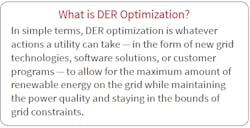In a new special report series, we explore how to optimize DERs on the grid. In this first installment, we look at what DERs mean to the grid.
When utilities first began to encounter distributed energy resources (DERs) connecting to their electric grids in large numbers, they raised concerns about the negative impacts, such as power line capacity overflows and higher grid upkeep costs for non-DER-owning utility customers.
However, a funny thing has happened in utility C-suites since the initial friction emerged. Thanks to the rise of new DER technologies such as battery energy storage systems (BESS) and microgrids, utility leaders increasingly see DERs as grid assets with the potential to reduce faults, prevent outages, meet localized demand peaks, and ultimately yield a more resilient grid.
Plenty of challenges remain, of course, to get to the vision of DERs as a resilience solution. Grand View Research estimates the global DER market will grow from about $25 billion in 2017 to $581 billion by 2027. In the United States, Wood Mackenzie estimates 175 GW of DERs will be installed from 2022 to 2026 — almost the equivalent capacity of the entire PJM market. Utilities are rushing to accommodate this wave of DER adoption across the United States, but many face interconnection backlogs and other delays that leave customers waiting months or even years. DERs that do connect leave grid operators facing constant and rapid change on the grid, which they are struggling to manage effectively because utilities often still lack the visibility, data, and control necessary to leverage DERs to their full potential. With current technology, it is cumbersome to keep changing the system, which affects operations and can cause outages for assets and customers.
The question remains open: How can utilities overcome the challenge to shift DERs from sources of grid stress to sources of grid resilience?
The answer is DER optimization.
It starts at a small scale, establishing the necessary visibility into the status of a single DER or cluster of DERs and a level of control that allows the utility to use DERs for flexible demand management or grid services such as voltage control.
Where should utilities start DER optimization?
Seen from the utility’s perspective as a grid operator, microgrids and clusters of microgrids are viewed much like any other DER. However, they tend to have traits that make them the perfect DERs for flexible load management and localized grid support.
Microgrids — combinations of DERs such as solar PV and battery energy storage systems (BESS) featuring smart control systems — are experiencing rapid growth. A recent National Renewable Energy Laboratory report cited estimates of the global microgrid market ranging from $23 billion to $39 billion with double-digit annual growth expected.
Because microgrids can be installed with smart control systems that provide a granular level of control and visibility when connected to the grid, they offer an ideal starting point for DER optimization.
Download the full report “Control, Model, Scale: A Three-Phase Approach to Optimizing DERs on the Grid” courtesy of Siemens to learn more.









